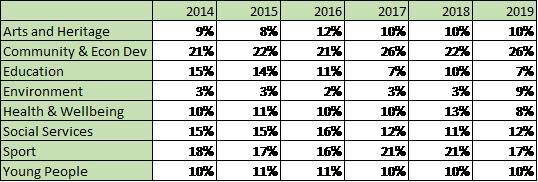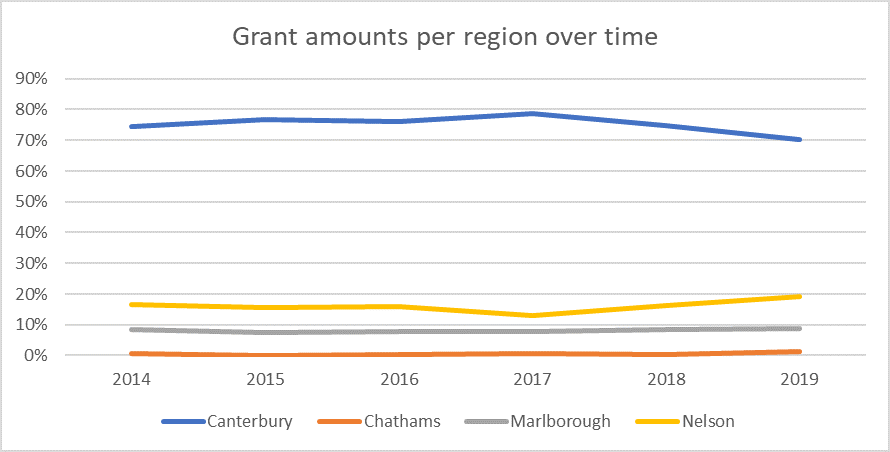
I last had a good look at Rata a good eighteen months ago. What I found there was some increases in the amounts given, to fewer groups. I had noted a change of Trustees given the change of government (Trustees are appointed by the Minister of Finance) and wondered if there would be material changes in where the money goes. Since then, we have had two more funding years published, so I’ve taken a deep breath and jumped on in. I’ve found a few pretty interesting things:
- Top of the South (Nelson and Marlborough regions) got 30% of 2019 grants, whilst having 23% of the population
- Rugby is still the number one sport getting funding from Rata.
- They are giving fewer, bigger grants.
- The cost per grant has shot up by over $1500. This is driven by both rising costs and fewer grants.
They have also changed the way their grants work into several different buckets: Support, Connect etc. This doesn’t actually tell us much: indeed the bucket any particular group is allocated to can vary year by year. So I have used their old classifications although of course with some of my own bias in classification.
Another wee quirk is the use of “Special Funds”. After the quakes the Foundation put aside a wedge of capital - $25m – to help with Canterbury recovery (although Top of the South did receive about 20% of this money). Similarly after the Kaikoura earthquakes, around $1.2m was allocated to recovery. For the sake of analysis these funds are excluded from the following numbers.

The next question is where the money went. Answer: the usual suspects. I was surprised again to see this: as any reader of mine knows, there are plenty for places for sports to get grants. Indeed, rugby has its own pokie! Community and Economic has grown a bit. I have tagged all the money given over to capacity building here: it’s the latest and greatest for grant makers to throw money at (although, as one lovely chap running a really innovative TSO told me the other day, I don’t need some kid coming in and telling me how to run my organisation!). We also have a couple of large chunks to one or two capital projects.
Sport has seen a jump in 2017 and 2018 with a fall again in 2019. Organisers of Sport, such as Sport Canterbury or Sport Tasman, have received the most at $437k. As far as codes go, rugby got the biggest chunk in the 2019 year totalling almost $400k, driven by a big $200k grant to the New Brighton Rugby Club (presumably capex). Cricket was second getting just shy of $250k, tennis received $221k, and basketball $203k.
Environment had a big jump in 2019 due to $1m going to a stoat eradication project on D’urville Island. Health and Wellbeing too has fluctuated, namely due to a couple of large capital donations in 2018. A few organisations who always did receive funding no longer do: as Rata doesn’t publish declines I don’t know whether they didn’t ask or they were turned down. Interestingly Social Services has dropped a bit too, from 15% of funds five years ago to 12% these days. While social services do have the highest average grant ($30k rather than the average of $22k) the actual quantum given has dropped by around $500k.
The trend I noticed previously has continued: namely the average amount of a grant increasing. This is up from an average grant of $15k in 2014 to $22k in 2019. The number of grants too has reduced, from 1240 in 2014 down to 841 in 2019. And this last figure is overstated what with my fudge for multi-regions.
The last question is how much it costs to get a dollar into the community. If we look at a simple figure of the staff costs divided by the total grants given, it now costs 9 cents for Rata to get $1 into the community. This is up from 6.4 cents in 2014. This is driven by staff costs increasing around 50% over this time period, which is rather interesting, especially given fewer grants are being made now. We can put this another way: looking at total costs, in 2014 the cost per grant was $2262, in 2019 this rose to $3962. Now we could argue that better decisions are being made: of course there is (at this stage) no way to measure this. However, the irony is not lost on me: sure as eggs if a TSO’s costs had risen so much you can be sure the funder would be asking some questions.
Then of course there is the other side: the time and cost for an organisation applying for a grant. Anecdotally I have heard some pretty outrageous numbers on this. The challenge is that Rata is the biggest funder in the area, putting around 30% of total grants into the region. The power imbalance is out of whack. Media publishes its good news stories (although there has only been one press release this financial year), academia isn’t interested in the ecosystem (I’ve asked!), government perhaps sees organisations such as Rata as a way create a diversion from actually funding TSO provided services sufficiently, and TSOs are obliged to fawn and laugh at all the funder’s jokes in order to keep a relationship, while privately grumbling. This organisation was set up for citizens of the area covered by the old Canterbury Savings Bank, and as such, us citizens do need to give a rats. Power corrupts after all, and, as The Tuesday Club weekly emails say (stolen themselves from The Washington Post), Democracy dies in darkness.
I write about this stuff as believe that as need to understand where funding comes from, where it goes, and how it gets there. As a citizenry we allow both those supplying money and those asking for money to operate, and as a community we need to ensure we have oversight over the organisations they choose to fund. Love to talk with you if you think this is at all interesting, and if you want to dive into the data a bit more than happy to do so. Check out my website http://www.delfi.co.nz/

 RSS Feed
RSS Feed